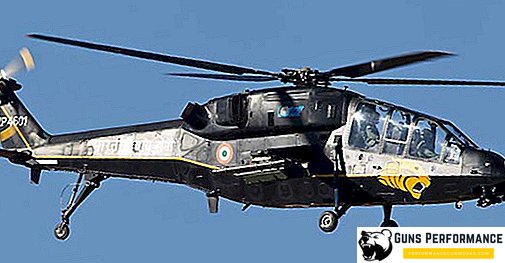The Navy is one of the most effective tools of geopolitics. The American admiral Alfred Mahan in his book, The Influence of Sea Power on History, stated that the fleet influences politics by the very fact of its existence. It's hard to argue with that. For more than two centuries, the borders of the British Empire were determined by the pennants of its warships, and in the last century, hegemony in the oceans passed to the US Navy. The main striking force of the American fleet are aircraft carriers - huge floating airfields, with the help of which the US is firmly and confidently imposing its interests on the whole world.
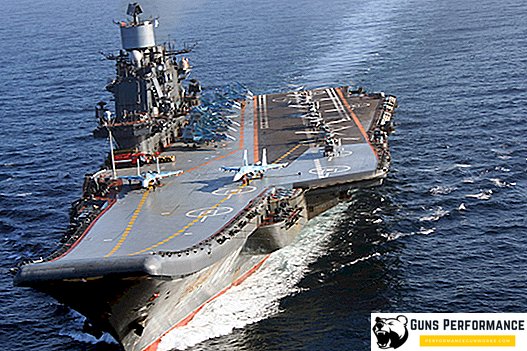
And what about Russia? At present, the Russian Navy is armed with one ship capable of providing the take-off and landing of aircraft of the classical aerodynamic configuration - this is the Admiral of the Fleet of the Soviet Union Kuznetsov heavy aircraft carrier (TAKR or TAVKR).
"Admiral Kuznetsov" was designed and built in the Soviet Union, it became the first real Soviet aircraft carrier and the further development of the heavy aircraft carrier cruisers of the project 1143 Krechet. The main difference between the Admiral Kuznetsov TAKR and the majority of aircraft carriers is the presence of missile weapons (PKR Granit).
For many years, disputes over whether such a ship is necessary for the Russian Navy do not subside, do Russia need aircraft carrier at all?
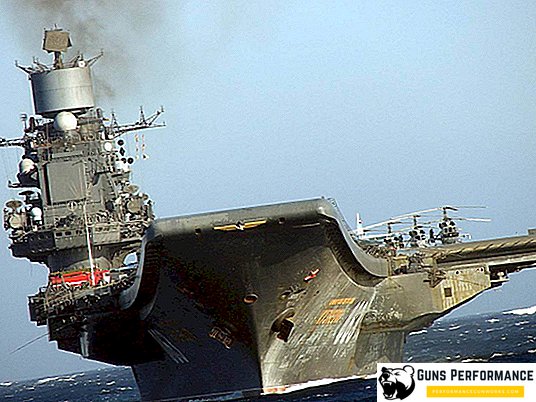
After being launched in 1989, this heavy aircraft-carrying cruiser spent most of its time not on the march, but on the quay walls of the repair docks. Due to the low reliability of the ship's mechanisms, the only Russian aircraft carrier on hikes always accompanies a tugboat, which in case of anything can come to the rescue. The military industry of Russia has not been able to provide this ship with a sufficient number of combat aircraft, and even less prepared pilots are able to take off and land on the ship's deck.
Naval sailors call this ship "Kuzya", and it is very difficult to say, affectionate is a nickname or contempt.
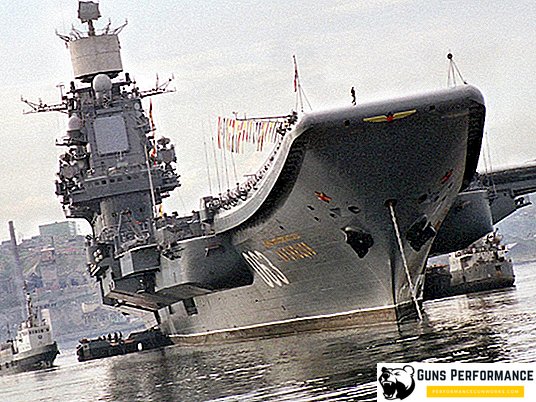
The history of the creation of TAKR "Admiral Kuznetsov"
The first aircraft carriers appeared at the dawn of the XX century, almost immediately after the emergence of military aircraft. At first they were considered as auxiliary ships, which should ensure the effective actions of the main striking force of the naval forces of that time - battleships.
However, everything changed radically on December 7, 1941. On this day, Japanese aircraft sank most of the American battleships in the harbor of the Pearl Harbor base. Almost immediately after that, the United States laid 24 aircraft carriers of the Essex type. These ships, in fact, allowed the Americans to win the war in the Pacific.
The most powerful battleship of the Japanese Navy, Yamato, was destroyed by American aircraft, without causing any serious damage to the enemy.
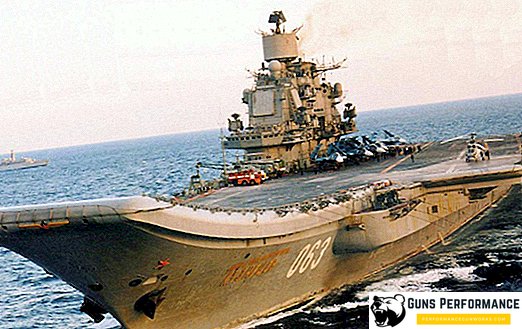
After the end of the Second World War, it became clear that aircraft carriers were the new rulers of the oceans, and the leading maritime powers were actively engaged in the construction of such ships. In 1961, the first aircraft carrier with a nuclear power plant was launched in the USA.
In the USSR, aircraft carriers received relatively little attention. Stalin liked the huge, powerful battleships more, and few dared argue with him. An ardent supporter of the construction of aircraft carriers in the Soviet Union was Admiral Nikolai Gerasimovich Kuznetsov. Largely due to his efforts, the first projects of aircraft carriers appeared in the pre-war years, but did not go further than the sketches and drawings. Projects were developed at once by two aircraft carriers: a large one (for 72 aircraft) and a small one (for 32 aircraft), but they were deleted from the post-war fleet development plans. Finally closed the projects of the Soviet aircraft carrier Admiral Gorshkov.
Soviet propaganda painted aircraft carriers as weapons of aggressive war inherent in imperialism. The effectiveness and combat power of these ships was underestimated, and the capabilities of the Soviet missile cruisers, on the contrary, were exalted and overstated. Khrushchev was an ardent admirer of missile weapons and submarine fleet, so with him the main resources of the Soviet Union were thrown into the creation of strategic submarines.
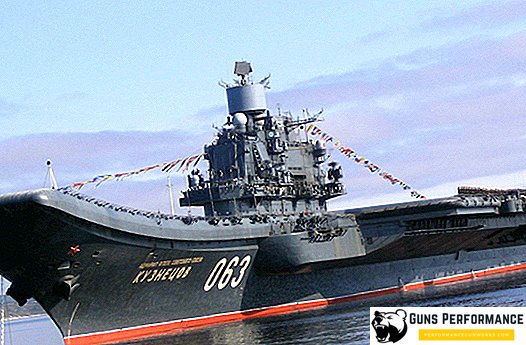
After Brezhnev came to power, the USSR resumed the development of aircraft carrying ships. In the late 60s, the Yakovlev Design Bureau designed the Yak-38 vertical take-off and landing aircraft, which Yakovlev wanted to put on the fleet. Especially for this car in 1972 was built aircraft carrier "Kiev", which in addition to airplanes was also armed with anti-ship missiles P-500 "Basalt".
A total of four project 1143 ships were launched into the water: the Kiev, Minsk, Novorossiysk and Baku. However, the Soviet Navy was seriously disappointed: the Yak-38 turned out to be a very unsuccessful vehicle, it could not take off with full refueling and armament, and in the tropics the aircraft engines refused to start at all. Despite numerous improvements, it was not possible to turn this aircraft into a reliable and effective combat vehicle.
The heavy aircraft-carrying cruiser "Admiral Kuznetsov", in fact, is a continuation of project 1143. They planned to manufacture three ships, the main difference of which was the possibility of taking off and landing on the deck of aircraft with the traditional scheme. "Admiral Kuznetsov" was laid in 1981, the cruiser "Varyag" - in 1985, and the "Ulyanovsk" - in 1988.
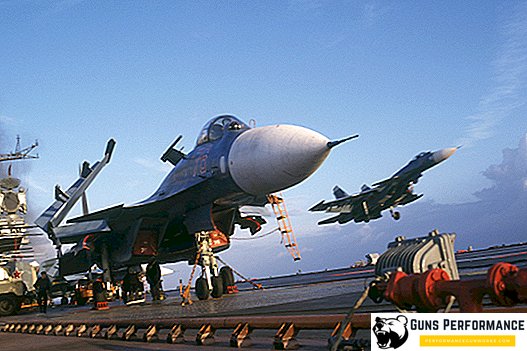
After the collapse of the USSR, the cruiser Varyag went to Ukraine, it was 67% ready. In 1998, this ship was sold to China. For a long time, it was used as a floating casino, but in 2008, the Chinese began its completion. In 2011, Varyag received a new name, Shi Lan, and became the first Chinese aircraft carrier. The Chinese Navy is likely to use the ship as a training ship.
The fate of the aircraft carrying cruiser Ulyanovsk, founded in 1988, turned out to be even more sad: it was cut into metal right on the stocks. This ship was planned to be equipped with a nuclear power plant and a steam catapult.
Design work on the cruiser "Admiral Kuznetsov" began in 1978. This ship was originally designed to ensure the take-off and landing of traditional planes.

The new ship was born very difficult, developers were hampered by conflicting requirements for the appearance of the aircraft carrier, coming from the Ministry of Defense and from the leadership of the Navy. The project was developed by the Leningrad PKB, the designers offered customers five projects of a new ship, one of which was to equip it with a nuclear power plant. Only in 1982, the project was officially approved, and construction began at the Black Sea Shipbuilding Plant (Nikolaev).
During construction, a progressive technology was used, which consisted in the formation of a ship hull from ready-made large blocks. At the same time in the Crimea (Saki) a ground complex "Thread" was created, where pilots practiced the skills of take-off and landing on the ship's deck. Initially, the aircraft-carrying cruiser bore the name "Riga", but in November 1982 (after the death of the Secretary General) it was renamed "Leonid Brezhnev". In 1987, the ship received a new name - "Tbilisi", and in 1990 - "Admiral Kuznetsov".
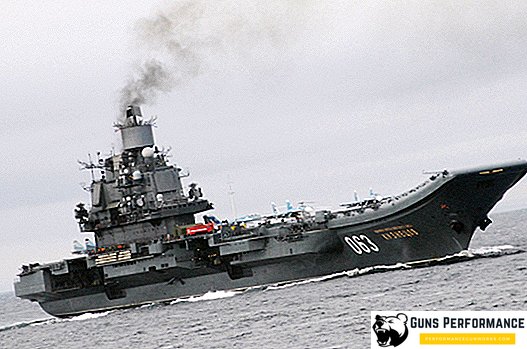
Instead of PKR "Basalt", the cruiser received more modern Granit missiles, the length of the flight deck was significantly increased, instead of a steam catapult, the ship received a springboard in the bow.
In 1989, the ship began running trials, at the same time the first successful landings and take-offs of aircraft from the ship’s deck were made. Aircraft cruiser showed good performance. January 20, 1991 "Admiral Kuznetsov" was adopted in the Northern Fleet of Russia.
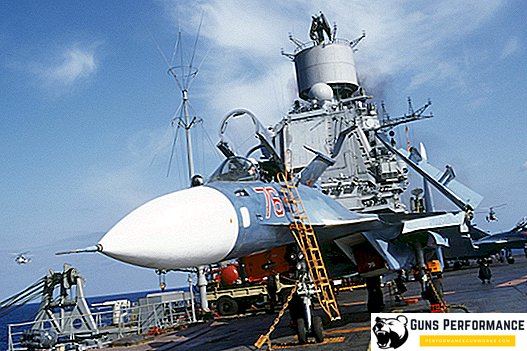
The design of the cruiser "Admiral Kuznetsov"
The heavy aircraft-carrying cruiser "Admiral Kuznetsov" is a continuation of the ships of Project 1143, but in a number of its characteristics it differs significantly from them. Its appearance more like a classic cruiser aircraft carriers, it has a so-called through-deck and springboard in the bow of the ship. The angle of inclination is 14.3 °. The deck area is 14,800 m2. The cruiser is equipped with an aviation finisher and an emergency barrier.
The Admiral Kuznetsov was the first to use underwater surveillance equipment (PKZ).
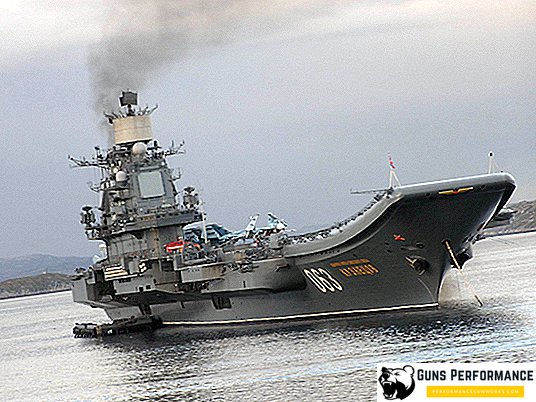
To lift the aircraft from the hangars on the "Admiral Kuznetsov" there are two lifts that can lift up to 40 tons. The ship superstructure (the “island”) has 13 tiers, it is shifted to the right, which made it possible to increase the width of the runway. The deck has a special heat-resistant coating "Omega", which can withstand temperatures up to 450 ° C.
The hull is welded, it has seven decks and two platforms. The bottom is double the entire length. The hangar for aircraft (LA) occupies 50% of the length and 70% of the width of the aircraft carrier. In addition to the aircraft, it housed tractors, fire trucks, as well as equipment for the repair and maintenance of aircraft and helicopters. In addition, the hangar is equipped with an aircraft transportation system, so tractors are only needed for work on the upper deck. Aircraft are placed in the hangar with folded wings, and helicopters - with the rotors removed.
Launchers PKR "Granit" are located at the base of the springboard, on top they are covered with armored covers. The complexes of the Dagger air defense system are located in the sponsors on the bow and stern of the ship.
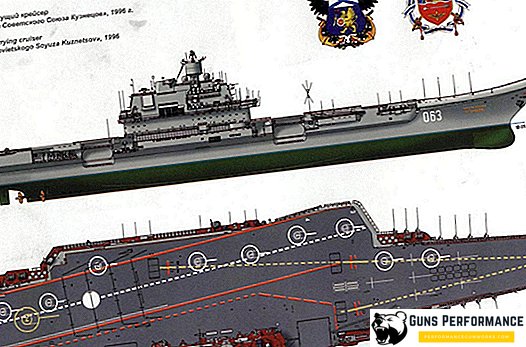
The Svetlana-2 air finisher is a system of several cables strung over the deck. They are connected with the hydraulic system, which extinguishes the energy of the aircraft landing on the deck.
On the aircraft carrier there are several navigation systems that help pilots land on the ship. The unique optical system "Moon" was also installed, which allows pilots to visually determine the correctness of the approach.
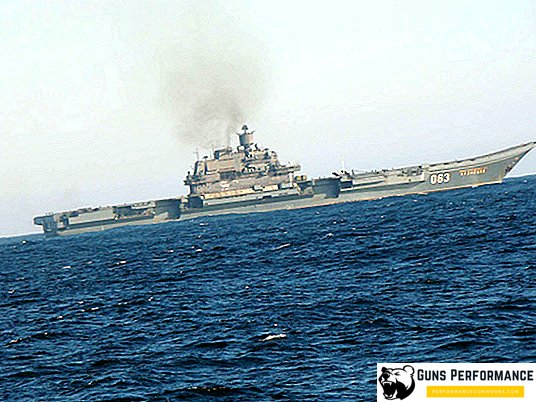
In addition to combat aircraft, the main armament of the heavy cruiser is the RCC Granit. Twelve missiles are placed in silo-type launchers located in the bow of the ship. To protect the ship from the air, the Dagger SAM (24 PU, 192 missiles) and ZKBR Kortik (8 PU, 256 missiles) and six AK-630M rapid-fire systems can be used. Also, the aircraft carrier is armed with two RBU-12000 "Boa" (60 depth charges).
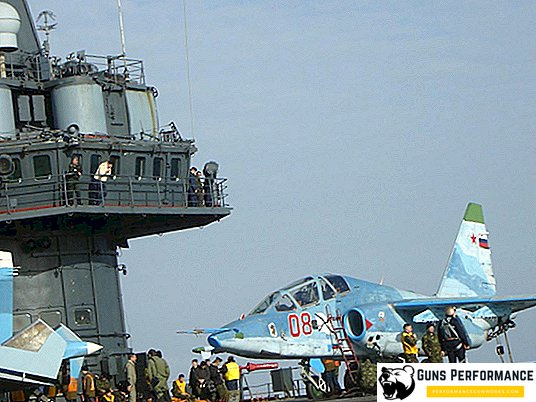
However, the main armament of the ship are combat aircraft, which are on board. These are 50 aircrafts: 26 deck fighters and 24 helicopters.
Admiral Kuznetsov’s electronic equipment is very diverse and includes 58 different items. Among them:
- BI-MS "Le-co-rub";
- Complex "Mar-Pas-Sat" with PAR;
- Three-co-or-di-nat-tion radar "Fre-ha-t-MA";
- Radar about-to-the-ru-tion of the low-lo-ty-tshie-tse-lei "Pod-kat";
- Kompleks plex-zi "Buran-2";
- Kompleksy EW "Co-zvez-die-BR".
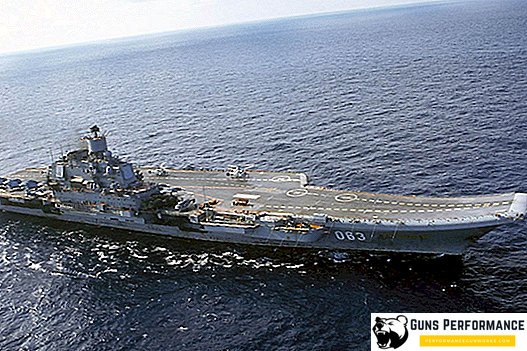
The power plant almost completely repeats the scheme used on other ships of the project 1143. It is a steam turbine, four-shaft, with a capacity of 20 thousand liters. with. The main power plant allows the ship to develop a full speed of 29 knots and overcome an 8-knot turn of 8 thousand miles.
The installation consists of eight boilers, there is no auxiliary power unit.
The movement is carried out due to the rotation of four bronze screws.
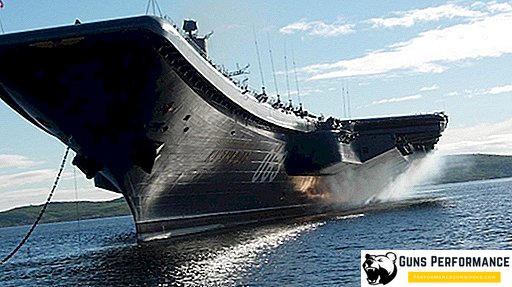
Operation TAKR "Admiral Kuznetsov"
Until 1994, various tests were carried out on the ship; he received new aircraft. In early 1995, the repair of shipboard boilers was carried out. At the end of 1995, as part of the Admiral Kuznetsov ship group, he set off on a campaign in the Mediterranean. The ship visited Tunisia, Crete, Syria and Malta. At the end of the cruise, the cruiser participated in large-scale exercises. Reflect air attacks, the detection of enemy submarines, rocket and artillery firing.
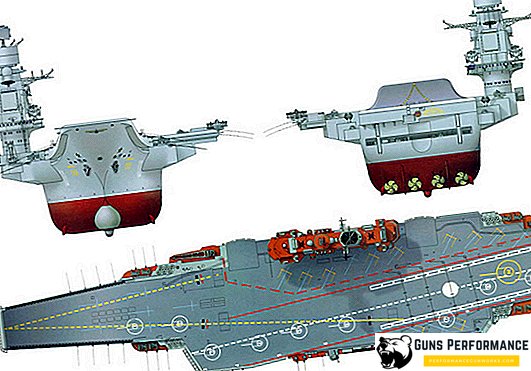
From 1996 to 1998 the ship was under repair. In 2000, "Admiral Kuznetsov" took part in exercises, during which the submarine "Kursk" crashed. From 2001 to 2004 the ship was under repair.
In 2018, the aircraft carrier went to the Mediterranean Sea to lead the Russian Navy grouping there.
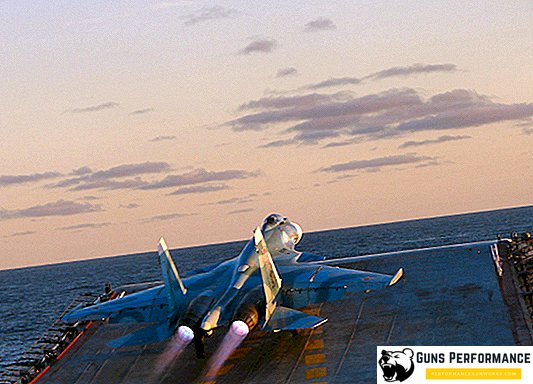
Project evaluation of the aircraft carrier "Admiral Kuznetsov"
Aircraft-carrying cruiser "Admiral Kuznetsov" with full confidence can be called a full-fledged aircraft carrier. However, the rejection of steam catapults significantly complicated the use of carrier-based aircraft. Springboard seemed to developers a good (and cheap) alternative to catapults, but he could not completely replace them. Su-33 aircraft are capable of solving only air defense tasks, but they cannot effectively deliver strikes against ground targets or enemy ships. Moreover, taking off with the help of springboard imposes restrictions on the take-off mass of the aircraft, which means a decrease in their fuel reserves and weight of weapons.
According to unofficial information, aircraft takeoffs are carried out only upwind in windy weather. Pilots prefer not to use the ship’s navigation systems, but to fly only with good visibility. Of the entire squadron, only 6-7 aircraft are usually ready for flight.
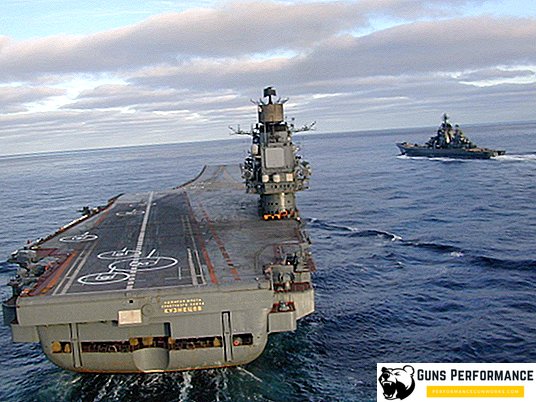
There are many complaints about the ship’s energy system. Virtually every exit to the sea is accompanied by a more or less serious freelance situation related to the work of the GEM. It should be noted that in every long hike, "Admiral Kuznetsov" is accompanied by a tug. Described several cases of complete loss of the course of the ship, almost ended in disasters. On the cruiser there were several serious fires that led to human casualties.
Some experts believe that the "Admiral Kuznetsov" is not of serious value as a combat unit. Moreover, its operation is dangerous and very expensive for the Russian budget. Ship offer to conserve.
If Russia plans to develop its navy, then it can not do without aircraft carriers. "Admiral Kuznetsov", like other ships of the project 1143, can be called one of the stages of development in this direction. Aircraft-carrying cruisers of project 1143 allowed the Russian fleet to accumulate the necessary experience, learn how to manage and properly use these huge and very complex ships.
Not so long ago, information appeared that a large-scale modernization of Admiral Kuznetsov was planned, during which outdated ship’s electronic equipment, powerplant and some weapon systems would be replaced.
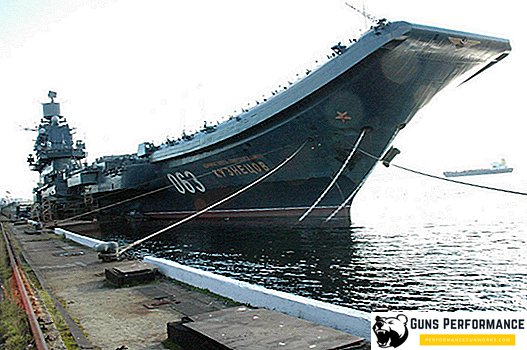
Technical characteristics of the Admiral Kuznetsov TAKR
| Main characteristics | |
| Displacement, t: | |
| standard | 43000 |
| full | 55000 |
| the greatest | 61390 |
| Main dimensions, m: | |
| maximum length (at a constructive waterline) | 306,45 (270) |
| width is the greatest (by CVL) | 71,96 (33,41) |
| average sediment (Dst / Dnorm / Dfull) | 8,05/8,97/9,76 |
| maximum draft | 10,4 |
| Main power plant | boiler-turbine, 8 boilers KVG-4 in 4 autonomous groups |
| Power, hp (kW): | |
| total 4 GTZA TV-4 | 200000 |
| turbogenerators TD-1500 | 6x1500 |
| DGR-1500 diesel generators | 4x1500 |
| Number of shafts, pcs | 4 |
| Number of screws, pcs | 4 |
| Screws | Four-bladed |
| Speed, knots: | |
| the greatest | 29 |
| economical | 14 |
| combat economical | 18 |
| Sailing distance, miles: | |
| at a speed of 14 knots | 8417 |
| at a speed of 18 knots | 7680 |
| at 29 knots | 3850 |
| Autonomy, days | 45 |
| Crew for the project, people: | |
| officers | 520 |
| midshipmen | 322 |
| sailors | 1138 |
| The actual crew, people: | |
| officers | 196 |
| midshipmen | 210 |
| sailors | 1127 |
| Armament | |
| Aviation, LA | 50… 52 |
| Su-33 and MiG-29K fighters or Su-25UTG attack aircraft | 26… 28 |
| Helicopters RLD Ka-34 | 4 |
| Ka-27 and Ka-29 helicopters (including Ka-27PS) | 18 (2) |
| Shock | PKRP "Granit-NK" |
| P-700 missiles, pieces | 12 |
| Installations for vertical start SM-233, pcs | 12 |
| Anti-aircraft missile | SAM "Dagger" |
| Installations for vertical start SM-9, pcs | 24x8 |
| ZUR 9M330-2, pcs | 192 |
| Anti-aircraft missile and artillery | ZRAK "Dirk" |
| Number of units, pcs | 8 |
| Missiles 9M311-1, pcs | 256 |
| 30-mm shells, pcs | 48000 |
| Artillery | ZAK AK-630M |
| Number of units, pcs | 6 |
| Anti-submarine / anti-torpedo | RBU-12000 "Udav-1" |
| Electronic weapons | |
| BIUS | "Lumberjack" |
| General detection radar | PLC "Mars-Passat", 4 PAR |
| NLS detection radar | 2xMR-360 "Tackle" |
| NC detection radar | 3hMP-212 "Vaigach" |
| GUS | GAK MGK-355 Polynom-T, GAS MGK-365 Zvezda-M1, anti-sabotage GAS MG-717 Amulet, GAS Altyn, ZPS MG-35 Shtil, GAS MG-355TA |
| EW funds | "Constellation-RB" |
| Kopleksy noise interference | 2x2 PU PK-2 (ZIF-121), 4x10 PU PK-10 "Brave" |
| Fire control radar | 2x "Coral-BN", 4 radar control radar "Dagger" 3R95, 4 control section M against "Dirk" 3R86 |
| Navigation complex | "Baysur" |
| Radio navigation aids | "Resistor K-4", "Lawn" |
| Means of communication | complex "Buran-2", space communication complex "Crystal-BK" |








